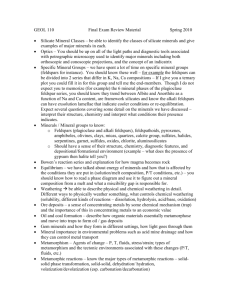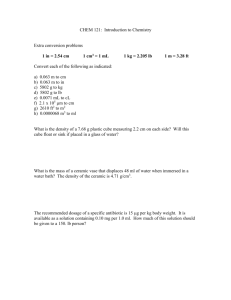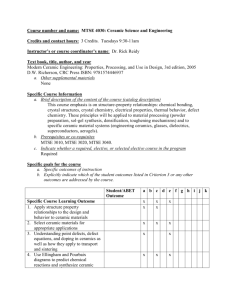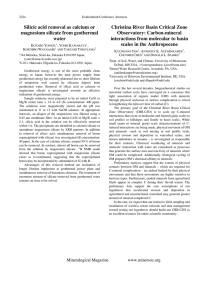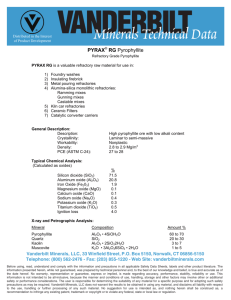Raw materials and their characterization
advertisement
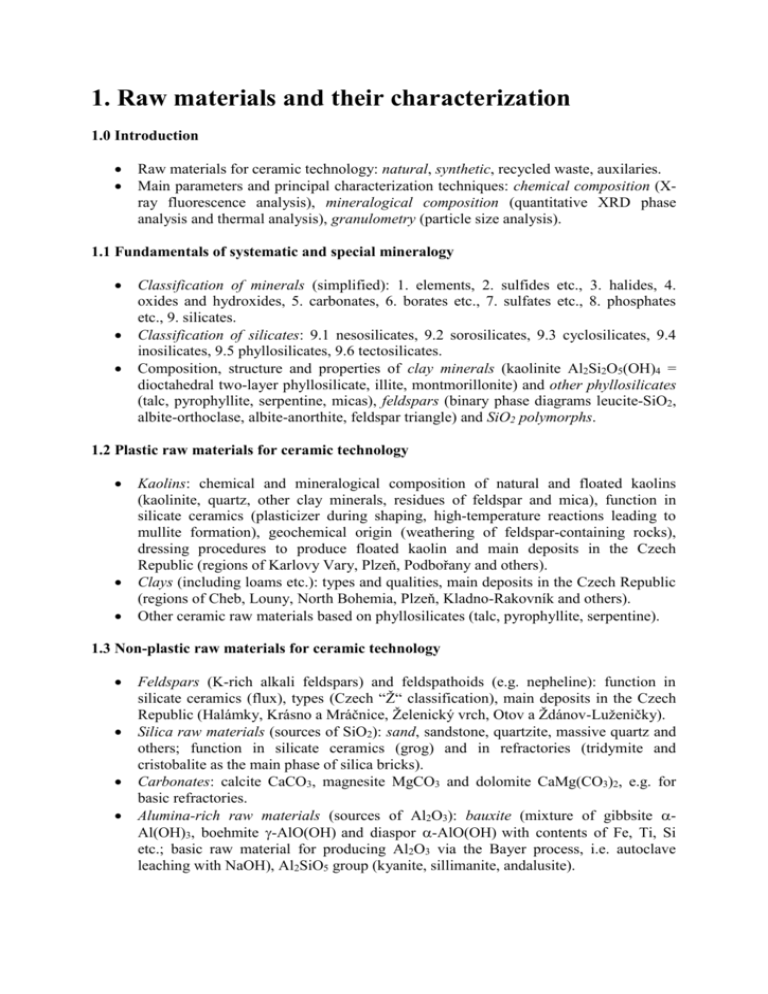
1. Raw materials and their characterization 1.0 Introduction Raw materials for ceramic technology: natural, synthetic, recycled waste, auxilaries. Main parameters and principal characterization techniques: chemical composition (Xray fluorescence analysis), mineralogical composition (quantitative XRD phase analysis and thermal analysis), granulometry (particle size analysis). 1.1 Fundamentals of systematic and special mineralogy Classification of minerals (simplified): 1. elements, 2. sulfides etc., 3. halides, 4. oxides and hydroxides, 5. carbonates, 6. borates etc., 7. sulfates etc., 8. phosphates etc., 9. silicates. Classification of silicates: 9.1 nesosilicates, 9.2 sorosilicates, 9.3 cyclosilicates, 9.4 inosilicates, 9.5 phyllosilicates, 9.6 tectosilicates. Composition, structure and properties of clay minerals (kaolinite Al2Si2O5(OH)4 = dioctahedral two-layer phyllosilicate, illite, montmorillonite) and other phyllosilicates (talc, pyrophyllite, serpentine, micas), feldspars (binary phase diagrams leucite-SiO2, albite-orthoclase, albite-anorthite, feldspar triangle) and SiO2 polymorphs. 1.2 Plastic raw materials for ceramic technology Kaolins: chemical and mineralogical composition of natural and floated kaolins (kaolinite, quartz, other clay minerals, residues of feldspar and mica), function in silicate ceramics (plasticizer during shaping, high-temperature reactions leading to mullite formation), geochemical origin (weathering of feldspar-containing rocks), dressing procedures to produce floated kaolin and main deposits in the Czech Republic (regions of Karlovy Vary, Plzeň, Podbořany and others). Clays (including loams etc.): types and qualities, main deposits in the Czech Republic (regions of Cheb, Louny, North Bohemia, Plzeň, Kladno-Rakovník and others). Other ceramic raw materials based on phyllosilicates (talc, pyrophyllite, serpentine). 1.3 Non-plastic raw materials for ceramic technology Feldspars (K-rich alkali feldspars) and feldspathoids (e.g. nepheline): function in silicate ceramics (flux), types (Czech “Ž“ classification), main deposits in the Czech Republic (Halámky, Krásno a Mráčnice, Želenický vrch, Otov a Ždánov-Luženičky). Silica raw materials (sources of SiO2): sand, sandstone, quartzite, massive quartz and others; function in silicate ceramics (grog) and in refractories (tridymite and cristobalite as the main phase of silica bricks). Carbonates: calcite CaCO3, magnesite MgCO3 and dolomite CaMg(CO3)2, e.g. for basic refractories. Alumina-rich raw materials (sources of Al2O3): bauxite (mixture of gibbsite Al(OH)3, boehmite -AlO(OH) and diaspor -AlO(OH) with contents of Fe, Ti, Si etc.; basic raw material for producing Al2O3 via the Bayer process, i.e. autoclave leaching with NaOH), Al2SiO5 group (kyanite, sillimanite, andalusite). Other non-plastic raw materials: zircon (ZrSiO4; basic raw material for the production of ZrO2 via thermal decomposition), ilmentite (FeTiO3; basic raw material for the production of TiO2 via autoclave leaching in H2SO4), forsterite Mg2SiO4, wollastonite (CaSiO3) and others, including synthetic raw materials (highly pure or mixed oxides with controlled stoichiometry). 1.4 Important characterization techniques for ceramic raw materials Thermal analysis (thermogravimetry, dilatometry and DTA) and high-temperature reactions occuring in ceramic raw materials (dehydroxylation and solid state reactions in clay minerals, thermal decomposition of carbonates etc.) XRD quantitative phase analysis (especially of clay minerals) Particle size analysis (sedimentation and laser diffraction) X-ray fluorescence analysis Complex exercise problem: Use the results of quantitative XRD phase analysis (evaluated by commercial software like X’Pert ® or Siroquant ®) to discuss, for selected floated kaolins the relation between phase composition, chemical composition (from producer’s data, determined by RFA) and particle size (determined by sedimentation or laser diffraction). Additional explicit questions: a.) Which minerals contain the alkali oxides ? Compare your XRD-based findings with the calculation of the so-called rational composition. b.) Which size fractions are enriched in quartz, which in smectites ? Compare your findings with available SEM micrographs. c.) What can be said about the geological origin and the possible industrial applications of the different kaolins ?




